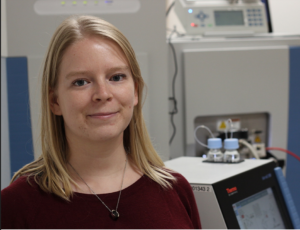
Dennis KAPPEI
About 98% of the human genome consists of non-coding DNA and more than half harbors repetitive sequences. At the moment, the function of most of these non-coding elements remains elusive despite an association of several of these elements with diseases such as cancer, diabetes and aging-related disorders. This is partly due to the fact that the modern molecular biology toolbox is adapted to research protein-coding genes. The study of protein binders to non-coding DNA sequences and RNA structures is an attractive entry point to examine the function of non-coding elements. To that end, we have established a quantitative mass spectrometry approach to identify proteins binding to nucleic acids. Applying this technique to telomeres, repetitive DNA at the extremity of chromosomes, we identified previously unreported telomeric DNA- and telomeric RNA-binders. Our work serves as a blueprint to functionally dissect additional repetitive elements as well as other important non-coding loci.
dennis.kappei[at]nus.edu.sg
Principal Investigator, Cancer Science Institute of Singapore, NUS
Assistant Professor, Department of Biochemistry, Yong Loo Lin School of Medicine, NUS
| 2013 | Georg Helm Prize, TU Dresden |
| 2005 – 2007 | Rotary Foundation Multi-Year Ambassadorial Scholarship |
| 2003 – 2007 | German National Merit Foundation Undergraduate Fellowship |
The expansion of genome size in the eukaryotic lineage is accompanied by a substantial increase in the amount of non-coding DNA elements. In the human genome, these regions comprise about 98% of the entire genome. Despite this high amount of non-coding DNA, most functional analyses have focused on the role of protein-coding genes. At the same time, protein-centric techniques traditionally dominate functional analysis. Such techniques include various immunoprecipitation approaches of the protein of interest and subsequent sequencing of the attached DNA/RNA species. While the availability of deep sequencing approaches has created a plethora of methods to analyze genome- and transcriptome-wide protein binding, these methods remain protein-centric. In particular, repetitive elements are usually excluded from analysis as mapping is ambiguous due to the short read length of current sequencing technologies and the fact that genetic manipulations are less straightforward compared to single loci. To access previously unexplored genomic elements, DNA-centric techniques that can be performed in an unbiased manner are valuable complementary approaches in the current research environment.
In an effort to establish a nucleic acid-centric approach that is generally applicable to non-coding elements, we focused on telomere-binding proteins. Telomeres are the molecular caps at the end of chromosomes and in vertebrates they consist of hundreds to thousands of repeats with the motif TTAGGG. Due to the end replication problem and active end processing telomeres shorten with every cell division, ultimately leading to cellular senescence. Cancer cells would eventually share this fate. However, they developed two mechanisms to defy telomere shortening: 85% of all tumors reactivate the expression of the reverse transcriptase telomerase which adds telomeric repeats de novo, while the other 15 % use a recombination-based mechanism, termed Alternative Lengthening of Telomeres (ALT). Telomeres represent an example of repetitive non-coding DNA with a well-studied functional role. Using a DNA pull-down assay based on in vitro reconstitution combined with quantitative mass spectrometry, we identified HOT1 as a direct telomere binding protein. In vivo, HOT1 acts as a dynamic telomere-binding protein with increased telomere association during active telomere elongation. In agreement with this, subsequent experiments have shown that HOT1 likely contributes to telomerase recruitment. We have since extended this approach and systematically investigated telomere-binding proteins in 16 vertebrate species, creating a phylointeractomics map of telomeres from zebrafish to human. Among the most conserved factors, we identified ZBTB48 as another direct telomere-binder, which – diametric to HOT1 – limits telomere elongation. In addition to its telomeric function, we demonstrate through a combination of RNA-seq, ChIP-seq and expression proteomics experiments that ZBTB48 also acts as a transcriptional activator, showcasing how functional genomics techniques can be combined with our nucleic acid-protein interaction studies. We now apply our approach to investigate less characterized repetitive regions of the genome.
*These authors contributed equally to this work
#Shared correspondence







